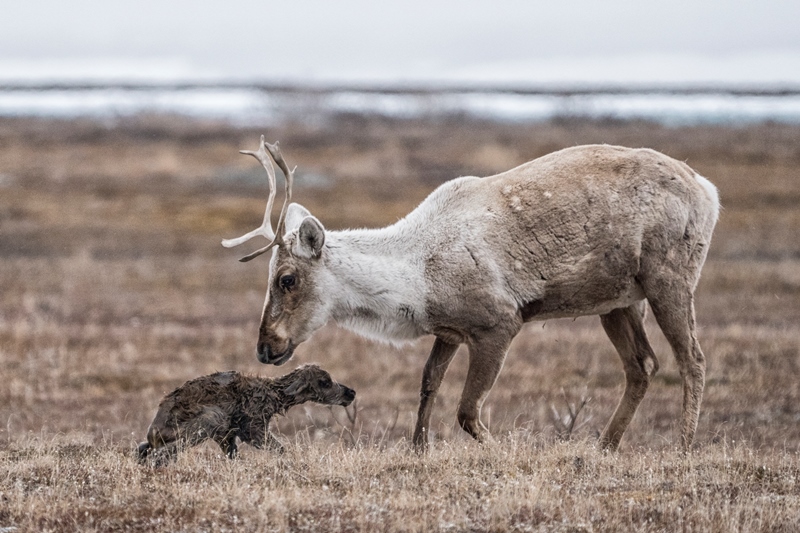It is early June on the coastal plain of Alaska’s Arctic National Wildlife Refuge. A cold wind blows in off the frozen Arctic Ocean, and with it blows a sheet of dry snow that covers the brown grass that stretches as far as the eye can see. When I get down on my knees and move the grass, I can see tiny green shoots punching their way out of the soil, reaching for the sun. These cotton-grass shoots have brought me here to photograph one of the greatest wildlife spectacles in North America: the birthing of the 200,000-strong Porcupine caribou herd.
I’ve been sitting in my tent for 18 hours, and I’m really, really hating it. It smells, I smell, everything is dirty, gross and boring. My only hope of photographing caribou calving is to stick it out in the tent as long as I can. There are caribou cows scattered around me in every direction, and if I leave the tent it will startle the animals, which will then disappear into the fog.

The Porcupine caribou herd is seen on the coastal plain of Alaska’s Arctic National Wildlife Refuge. (Peter Mather)
The moment I’ve been waiting for happens so quickly that I almost miss it. One cow stands up to stretch, she rotates in a circle and I can see a pair of feet sticking out of her back end. Two more circles and a grunt, then a tiny, mucus-covered caribou calf is lying 200ft (60m) away from me. Immediately, mom begins licking the placenta off her baby. Within 20 minutes, the calf is clean and they begin to slowly walk away. Within a week, the entire landscape will be a vibrant spring green with more than enough grass to feed 40,000 newborn caribou calves.

Thousands of caribou cross the Blow River in northern Yukon as they make their way from their calving and nursing grounds in Alaska’s Arctic National Wildlife Refuge. (Peter Mather)
For thousands of years the Porcupine caribou herd have migrated thousands of miles to birth and nurse their calves on this stretch of flat grasslands between the Arctic Ocean and the mountains of the North Slope. It offers better food – all those cotton-grass shoots – and fewer predators than the surrounding foothills and mountains. The breeze off the ocean also helps keep mosquitoes at bay.
Many conservationists and Indigenous people believe that the herd could not survive without this place. Unfortunately, it also lies on top of enormous oil and gas reserves that have sparked perhaps the longest-running environmental battle of our time.

Northern lights glow above the oil drills at Prudhoe Bay, Alaska. Oil and gas development just west of the coastal plain could give a preview of what may become of the refuge. (Peter Mather)
The 19-million acre (7.7-million hectare) Arctic National Wildlife Refuge was expanded in 1980. At the time of expansion, the coastal plain (also known as “the 1,002 lands”) was placed in a bureaucratic no man’s zone. The calving grounds are not protected, but congressional authorization is required to open the area to oil drilling. Over the past 30-plus years, Republicans in Washington, D.C. have made many attempts to open the calving grounds, and the battle is once again gearing up. The Trump administration has made drilling in the ANWR a priority in its recently released proposed budget.

Caribou from the Porcupine herd migrate to their wintering grounds in the Yukon. (Peter Mather)
Three months later and I’m on the banks of the Porcupine River, which gave the caribou their name, in northern Yukon, Canada. I’m 400 miles (650km) southeast of the calving grounds, but the caribou are migrating past on their way to their wintering grounds. The weather is eerily similar, a cold fog holds over the river, while a light rain squall peppers us.
My Gwich’in companion, Paul Josie, kneels over a blazing fire. The succulent brown meat of caribou fried in its own fat already warms our bellies. Josie has harvested three caribou – not for himself, but for the single women and elders in the community of Old Crow, who don’t have the means to hunt for themselves.

Paul Josie smokes caribou meat in the community of Old Crow in Canada’s Yukon Territory. (Peter Mather)
The Gwich’in are caribou people, spread across 13 villages on the outskirts of the Porcupine caribou herd’s range, and they depend on the animals for their physical and cultural sustenance. Josie seems most at home on the land. It’s land that his people roamed for thousands of years before any Europeans had set foot on the shores of North America.
Hours earlier when Josie was butchering the caribou, he stopped when he got to the heart, held it in his hand and told me, “We have a story. A legend … of how every caribou heart has a piece of Gwich’in in it … and every Gwich’in has caribou in our hearts. We are connected.”
Sitting around the fire, we talk about the efforts by the Gwich’in to protect the Arctic refuge. I ask Josie about why he has gone to Washington so many times, into what seems to me a different and indifferent world, to lobby U.S. congressmen and senators in what too often feels like a pointless exercise.
He replies: “I don’t have a choice. A threat to the caribou is a threat us … to our way of life.”

Darcy Andre, a Gwich’in youth, takes a photograph of the spoils of a successful caribou hunt on his iPad. The Gwich’in are always working to find a balance between their traditional lifestyle and thriving in the modern world. (Peter Mather)
